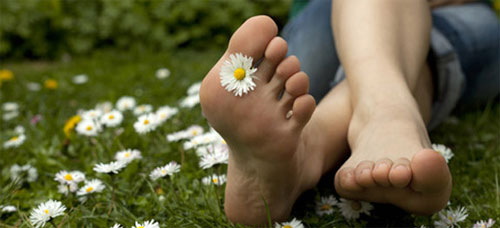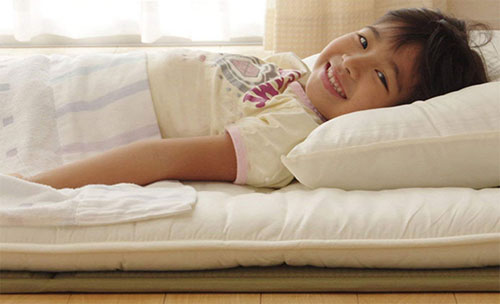Grounding – a simple, pleasurable way to reduce inflammation and chronic disease
Did you know the energy from the Earth can help you live a healthier life? The concept is known as earthing or grounding, which is no more complicated than walking barefoot.

In Down to Earth — which received the IndieFEST Award of Excellence for a short documentary in January 2017 — experts speak to shed light on this super simple yet commonly overlooked way to protect and improve human health. As cardiologist, Dr. Stephen Sinatra, author of Earthing: The Most Important Health Discovery Ever? explains in the film: “Grounding is literally putting your bare feet on the ground. When you do that, you’re in contact with the Earth, and mother Earth is endowed with electrons, and these electrons are literally absorbed through your feet. It’s like taking handfuls of antioxidants, but you’re getting it through your feet.”
Your Body Needs Grounding
Research suggests a general lack of grounding, also referred to as “electron deficiency syndrome,” has a lot to do with the rise of modern diseases. In this regard, an experiment conducted by Gary Schwartz, Ph.D., at the University of Arizona, is interesting. Using sunflowers, he demonstrates the biological effects of grounding and what happens when the flowers are not grounded.
It’s not unusual for modern people to spend entire days without being grounded. But though it has become the norm, it’s completely unnatural, and didn’t really become widespread until the advent of shoes with artificial soles that prevent grounding. When you’re grounded, free electrons from the Earth are transferred into your body, and these free electrons are among the most potent antioxidants known to man.
As electrons are negatively charged and free radicals are positively charged, any free radicals encountered in your tissues are electrically neutralized or canceled out by these free electrons. This is why grounding is so effective against chronic inflammation. Dr. Laura Koniver, who discovered grounding quite by accident after it seemed to soothe her crying infant, says in the film: “Grounding supports the body as a whole but it specifically supports organ systems down to the tissues and the cellular function of the entire body.”
Also, while you may not think of your body as a generator of electricity, you are very much an electrical being, and this is in large part why it’s so important to use grounding to harness the electrical charge of the Earth. In the film, Gaetan Chevalier, Ph.D., an engineer/physicist who has studied grounding, explains: “Unbeknownst to us, we live inside a battery. The surface of the Earth is charged negatively and the ionosphere, a layer of the atmosphere about 60 miles up, is ionized by the sun. The rays of the sun are so strong that they split the molecules in two, a positive charge and a negative charge.
The negative charges are transferred to the surface of the Earth, through lightening mainly, and the positive charges stay 60 miles up. The problem arises when we don’t have a negative charge. We need grounding just as we need air and we need sunshine.”
Grounding Reduces Electric Field Induction
There’s even evidence that grounding reduces the voltage induced on your body from electricity in your environment — a factor that has become increasingly important in the modern world. As noted in a 2012 review:
“Applewhite, an electrical engineer and expert in the design of electrostatic discharge systems in the electronic industry, was both subject and author of the study. Measurements were taken while ungrounded and then grounded using a conductive patch and conductive bed pad … Each method (patch and sheet) immediately reduced the common alternating current (AC) 60 Hz ambient voltage induced on the body by a highly significant factor of about 70 on average.

The study showed that when the body is grounded, its electrical potential becomes equalized with the Earth’s electrical potential … This, in turn, prevents the 60 Hz mode from producing an AC electric potential at the surface of the body and from producing perturbations of the electric charges of the molecules inside the body.
The study confirms the ‘umbrella’ effect of earthing the body explained by Nobel Prize winner Richard Feynman in his lectures on electromagnetism. Feynman said that when the body potential is the same as the Earth’s electric potential (and thus grounded), it becomes an extension of the Earth’s gigantic electric system. The Earth’s potential thus becomes the ‘working agent that cancels, reduces, or pushes away electric fields from the body’.”
Benefits of Grounding
While it may sound ‘too easy’, the simple pleasure of walking barefoot can be a powerful health-promoting activity. A scientific review published in the Journal of Environmental and Public Health in 2012 found that grounding can help:
– Improve quality of sleep and feelings of restfulness upon waking;
– Reduce muscle stiffness and soreness;
– Reduce chronic pain;
– Normalize secretion of the stress hormone cortisol, so that it adheres to a typical cycle of peaking in the morning and dipping lowest at midnight. This in turn helps promote more restful sleep and improve blood sugar regulation and weight control;
– Reduce stress and balance your autonomic nervous system by stimulating the parasympathetic nervous system (which rules the “rest and digest” functions of the body) and quieting the sympathetic nervous system (which cues the “fight or flight” response);
– Reduce the severity of the inflammatory response after intense workouts;
– Raise your heart rate variability (your heart’s ability to respond to stimuli);
– Speed up wound healing;
– Improve mood. In one study, grounding for one hour significantly improved mood among adults;
– Reduce inflammation. In the film, grounding pioneer Clint Ober explains how grounding quenches inflammation: “Inflammation is produced by neutrophils, which are white blood cells. When you have an injury … a damaged cell … these white blood cells come over and encapsulate the damaged cell and … release reactive oxygen species, which rip electrons from the damaged cell and that destroys the damaged cell. If there’s not enough free electrons there to reduce the remaining radicals, they’re going to steal an electron from a healthy cell and in the process damage it. Then the message goes out to the immune system and another neutrophil does the same thing and eliminates that cell, and then you have a chain reaction”;
– Thin your blood, making it less viscous, by strengthening the negative electrical surface charge on your red blood cells. This improves their ability to repel each other and allows them to flow more easily through tiny capillaries, and is incredibly valuable as cardiovascular disease is correlated with thicker, slow-moving blood. It can also help protect against blood clots.
In fact, this blood-thinning effect is so profound that if you are taking a blood thinner such as Coumadin, you should consult your doctor before you start grounding regularly. You may need to lower your dosage to avoid overdosing on your medication.
Research published in the Journal of Alternative and Complementary Medicine revealed that two hours of grounding increased the surface charge of red blood cells, thereby reducing blood viscosity and clumping. According to the authors, “Grounding appears to be one of the simplest and yet most profound interventions for helping reduce cardiovascular risk and cardiovascular events”;
– Increase the structure of the water in your cells. Water is in every cell in your body, and this water is highly ordered (structured) and charged. If you don’t have properly structured water in your cells, it can impact the functioning of the much larger protein molecules (and others) that interface with the cell. The water inside the cell also interfaces with water outside the cell, which has the opposite charge, creating a battery effect.

Your body’s ability to generate electricity is actually a key part of your achieving health. Electrical charges delivered from cell to cell allows for nearly instantaneous communication within your body, and the messages conducted via these electrical signals are responsible for controlling the rhythm of your heartbeat, the movement of blood around your body and much more.
In fact, most of your biological processes are electrical. The water in your cells achieves its ordered structure from energy obtained from the environment, typically in the form of electromagnetic radiation, including sunlight and infrared heat.
But grounding may also play an important role. Just as water increases in structure when a negative charge is introduced by an electrode, the negatively charged electrons you receive when grounded help increase the structure of the water in your cells. By restructuring the water, you promote more efficient tissue healing. So, when you ground, you are charging every single cell in your body with energy your body can use for self-healing.
How and Where to Ground
While connecting just about any part of your skin to the Earth is beneficial, one area that is particularly potent is the center of the ball of your foot; a point known to acupuncturists as Kidney 1 (K1). It’s a well-known acupuncture point that conductively connects to all of the acupuncture meridians in your body. Exercising barefoot outdoors is a great way to incorporate earthing into your daily life and will also help speed up tissue repair and ease muscle pain associated with strenuous exercise.
The ideal location for walking barefoot is the beach, close to or in the water, as saltwater is a great conductor. (Your body is also somewhat conductive because it contains a large number of charged ions, called electrolytes, dissolved in water. Your blood and other body fluids are therefore good conductors.)
A close second would be a grassy area, especially if it’s covered with dew, and /or bare soil. Ceramic tiles and concrete are good conductors as long as they’ve not been sealed; painted concrete does not allow electrons to pass through very well. Materials like asphalt, wood and typical insulators like rubber or plastic will not allow electrons to pass through and are not suitable for barefoot grounding.
While any amount of grounding is better than none, research has demonstrated it takes about 80 minutes for the free electrons from the Earth to reach your blood stream and transform your blood, which is when you reap the greatest benefits. So, ideally, aim for 80 to 120 minutes of grounding each day.
How to Ground Indoors
Just as walking barefoot was once widespread, so too was sleeping on the ground. In the modern world, sleeping indoors serves to further insulate you from the Earth. There’s also the issue of elevation. When you are grounded, your body cannot carry a charge, which is good. The greater the distance between your body and the Earth, the greater charge your body carries. In fact, this has been precisely calculated. For every meter (3.28 feet) you are above the ground, 300 volts of charge will build up in your body. So, if you are in a second story bedroom, your charge would be 1,000 volts, on average, and this increased charge may increase your risk of health problems. For example, one 2009 study found a 40 percent increase in stroke risk among people living in multistory homes. Flying can also make you severely ungrounded.
When indoors, and/or at elevation, you can ground by:
• Using a grounding pad or grounding sheet to ground your mattress while sleeping;
• Keeping your bare feet on a grounding mat while working. Grounding mats work well provided you have a grounded electrical outlet and can be particularly beneficial if you live in a high-rise. A grounded outlet is generally identifiable by the fact it’s a 3-prong outlet with a ground port (bottom outlet). Most modern homes built after 1970 will have a grounded electrical system. When using an earthing mat, make sure your bare skin is in contact with it. There should not be a layer of clothing between you and the mat;
• Using a grounded yoga mat when practicing indoors. Research has shown doing yoga indoors on a grounded yoga mat helps reduce blood viscosity and exercise-induced inflammation, the same effects you’d expect from walking barefoot outdoors;
• Touching the faucet with one hand while shaving or brushing your teeth with the other;
• Taking off your shoes and placing your feet (bare or with socks) on the steel struts of the chair in front of you when flying in an airplane.

Grounding May Be Essential for Life and Health
It’s important to understand that grounding is not a “treatment” or “cure” for any disease or disorder. Rather, it is one of the key mechanisms by which your body maintains equilibrium and health. The human body evolved in constant contact with the Earth, and your body needs this continuous interchange of energy to function properly.
Free radical stress from exposure to pollution, cigarettes, pesticides, processed foods and electromagnetic radiation, just to name a few, continually deplete your body of electrons. The Earth, however, is always electron-rich and can serve as a powerful and abundant supply of antioxidant free radical-busting electrons, provided you make an effort to stay grounded.
Without a proper supply of antioxidants, the free radicals can overwhelm your system leading to oxidative stress, inflammation and accelerated aging. “We now know that oxidative stress causes disease. It causes inflammation,” Sinatra says. “But we have this Earth — Mother Earth — that’s going to give us all these free electrons.”
Again, exercising barefoot outdoors is a wonderful way to incorporate grounding into your daily routine. Alternatively, simply take off your shoes as much as you can when you’re outdoors to take advantage of the Earth’s natural healing potential.
yogaesoteric
September 16, 2019
